Building on innovations in digital healthcare comms: PRCA Health Conference 2021
The healthcare sector has been under extraordinary pressure throughout the pandemic and new technologies and processes have had to be adopted and embraced across all departments – particularly in communications.
One thing that has helped comms teams working in healthcare connect with the vast audience in need of guidance and correct information? The massive increase in people using social media – according to statistics shared during day one of this year’s PRCA Health Conference, half a billion people joined social media last year alone.
How can teams seeking to connect with both wide and niche audiences on a variety of health-related topics make use of these new ways to connect? For ‘The new digital frontiers: Identifying and leveraging emerging social platforms’ panel, Pulsar enterprise solutions consultant Tom Deacon, HAVAS Just:: head of digital Corin Baird and Ogilvy Health UK account director Charlotte Turner shared their takeaways from the last 18-months of challenge and opportunity and advice for stemming the tide of misinformation and sharing the right messages.
New avenues of engagement across generations
You may not find many old age pensioners keeping up with the latest healthcare trends via TikTok, but the tech innovations sped up by the pandemic have filtered across the generations in a variety of ways, across different platforms.
Healthcare professionals have joined social media channels to share their expertise with people stuck inside during the lockdowns and battle misinformation. They’re natural content creators, according to Corin:
‘There has been a lot of information and misinformation being shared, so the need to right wrongs, to get really involved in that has been massive,’ said Corin. ‘The healthcare community hasn’t been quite so vocal on that before.
‘We’ve got a generation who are digitally native and who are also healthcare professionals – they create great content. They can get in front of the public and get things out in a more interesting way, not just leaving a leaflet in a doctor’s surgery. And it can be done in a way that’s approachable, and dare I say, “snackable”?’
That’s TikTok and YouTube-savvy audiences covered, but how has social media opened-up new avenues to engage with older audiences?
‘For most older people, being comfortable with new formats takes them trying it themselves,’ said Tom. The move to digital appointments made necessary by social restrictions has meant more older people trying it. But video calls aren’t the only way healthcare professionals and comms practitioners can engage with them – health-related internet forums will continue to be their go-to, according to Tom:
‘People need that network of support. The older generations that came before the happier-to-share millennials and Gen Zs enjoy their anonymity. Older people will have more health problems, so you’ll have more conversations happening in those anonymous forums.’
How should teams adapt their message for each platform?
The panel mentioned pharma as a sector known for being slow to share information in order to engage their audiences and adopt new technology. The pandemic has changed this, and Charlotte had advice for teams not quite yet au fait with the new culture of audience-led sharing:
‘The main shift that could help a lot of brands, especially in pharma, is to move away from a broadcast-only mindset. If it’s on social, you can have more fun – fun and entertainment is a key driver for why people are on these platforms. You can’t force your mindset on them.’
‘Pharmacentical companies have to spend time on a campaign,’ Corin acknowledged. ‘But on social media, you need to continue that conversation to get true engagement. They’ll pay money to build a community, but then drop it. It’s maintaining that contact that’s going to be successful’.
Locking in the right influencer to help get your message out on the platforms they understand is a tried-and-tested way to get attention… but it only truly works if there is a genuine connection between your chosen ambassador and the story.
‘A recent successful campaign that comes to mind for me is something our colleagues in the US have been working on relating to rare lung diseases,’ shared Charlotte. ‘You have to go broad for these things – an influencer can be a beacon. We worked with Queen Latifah, and while that might sound like just throwing a big name at it, she has an authentic connection with the condition – her mother passed away from interstitial lung disease. For her, it was important to make people aware of the condition. Influencer campaigns have been trendy for a while now, but I don’t think the authenticity will ever go away – the story has to be there.’
Authenticity is especially important on TikTok. As covered by the panel, Generation Z and millennial users are socially-aware and politically-canny – they’re more likely to spot insincerity and to turn away from overly-fussy content.
‘Content on TikTok has helped with breaking down stigma around things like ADHD,’ said Charlotte.
‘Mental health is such a complex topic, too, but the sharing of experiences does lend itself to TikTok. It’s not overly produced. The best brand performance is when they haven’t injected their own brand guidelines into content. That move to native clothing of content is going to be a strong theme going forward.’
For more on healthcare comms, read this guest post from Evergreen PR’s Leigh Greenwood on how purpose-led approaches win in healthtech PR.
Thinking about using TikTok as part of your future campaigns? Here are five tips for getting started. And for how YouTube has changed influence, check out our interview with author and journalist Chris Stokel-Walker on what’s next for YouTube and influencer culture.






Leave a Comment